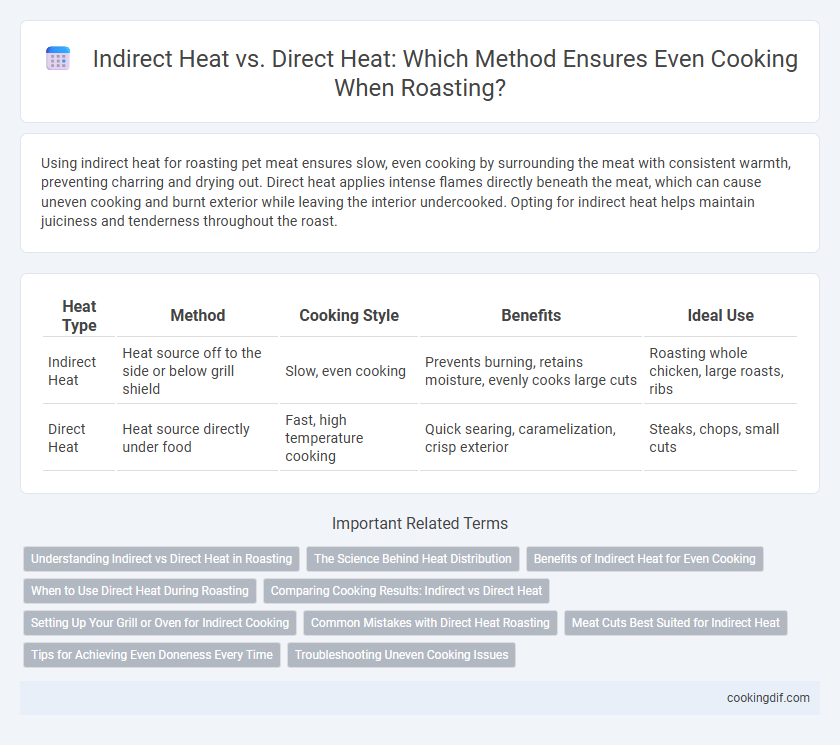Using indirect heat for roasting pet meat ensures slow, even cooking by surrounding the meat with consistent warmth, preventing charring and drying out. Direct heat applies intense flames directly beneath the meat, which can cause uneven cooking and burnt exterior while leaving the interior undercooked. Opting for indirect heat helps maintain juiciness and tenderness throughout the roast.
Table of Comparison
| Heat Type | Method | Cooking Style | Benefits | Ideal Use |
|---|---|---|---|---|
| Indirect Heat | Heat source off to the side or below grill shield | Slow, even cooking | Prevents burning, retains moisture, evenly cooks large cuts | Roasting whole chicken, large roasts, ribs |
| Direct Heat | Heat source directly under food | Fast, high temperature cooking | Quick searing, caramelization, crisp exterior | Steaks, chops, small cuts |
Understanding Indirect vs Direct Heat in Roasting
Indirect heat in roasting surrounds the food with consistent, moderate temperatures, allowing slow and even cooking that prevents burning and ensures thorough doneness. Direct heat exposes the food to intense flames or high temperatures, producing a seared exterior but risks uneven cooking or charring. Mastering the balance between indirect and direct heat leads to perfectly roasted dishes with optimal texture and flavor.
The Science Behind Heat Distribution
Indirect heat creates a convection environment where hot air circulates evenly around the roast, promoting uniform cooking and preventing burning. Direct heat applies intense, focused energy to the surface, often causing uneven temperature gradients that can char the exterior while leaving the interior undercooked. Understanding thermal conductivity and heat transfer through proteins and fats helps optimize roast cooking techniques for consistent doneness.
Benefits of Indirect Heat for Even Cooking
Indirect heat in roasting ensures even cooking by allowing heat to circulate around the food, preventing burning and overcooking on the surface. This method is ideal for larger cuts of meat or whole poultry, as it slowly cooks the interior while maintaining moisture and tenderness. Using indirect heat effectively reduces flare-ups, preserves natural flavors, and produces a consistently cooked roast with a juicy, tender texture.
When to Use Direct Heat During Roasting
Direct heat during roasting is ideal for searing meats to create a flavorful crust while locking in juices. Use direct heat for thinner cuts like steaks or poultry breasts that require quick cooking at high temperatures. This method ensures even browning and caramelization, enhancing the overall taste and texture of the roast.
Comparing Cooking Results: Indirect vs Direct Heat
Indirect heat in roasting ensures even cooking by surrounding the food with consistent, moderate temperatures that prevent burning and promote thorough internal cooking. Direct heat applies intense, focused heat that sears the exterior but risks uneven doneness and charring if not carefully managed. Comparing cooking results reveals indirect heat yields a juicier, uniformly cooked roast, while direct heat creates a crisp crust but may require finishing techniques to avoid undercooked interiors.
Setting Up Your Grill or Oven for Indirect Cooking
Setting up your grill or oven for indirect cooking involves arranging coals or burners on one side, creating a cooler zone where food cooks evenly without direct exposure to high flames. This method ensures consistent heat circulation, reducing the risk of burning while allowing slow, thorough roasting. Using a drip pan beneath the food helps manage flare-ups and keeps the cooking environment moist, enhancing flavor and tenderness.
Common Mistakes with Direct Heat Roasting
Direct heat roasting often causes uneven cooking as the intense temperature rapidly cooks the exterior, leaving the interior underdone or overcooked. Common mistakes include placing food too close to the heat source and not rotating or flipping the item, which results in burnt surfaces and raw centers. Proper even cooking typically requires indirect heat to allow gradual temperature distribution and thorough doneness.
Meat Cuts Best Suited for Indirect Heat
Indirect heat is ideal for larger, tougher meat cuts such as brisket, pork shoulder, and whole chickens, as it allows them to cook slowly and evenly without burning the exterior. This method maintains moisture and tenderness by using lower temperatures over a longer period, perfect for achieving a juicy, fork-tender texture. Roasting with indirect heat ensures thorough cooking while preserving the meat's natural flavors and preventing flare-ups common with direct flame exposure.
Tips for Achieving Even Doneness Every Time
Using indirect heat for roasting ensures even cooking by allowing heat to circulate around the food, preventing hot spots and burning. Position the roast away from the direct flame or heating element, and use a drip pan to catch juices and maintain moisture. Rotating the roast periodically promotes uniform doneness and helps achieve a tender, juicy result consistently.
Troubleshooting Uneven Cooking Issues
Indirect heat promotes even cooking in roasts by surrounding the meat with consistent, moderate temperatures, preventing charring and undercooking. Direct heat often causes uneven cooking by searing the exterior too quickly while leaving the interior undercooked. To troubleshoot uneven cooking, position the roast away from direct flames and use a roasting pan with a rack to ensure proper heat circulation and uniform doneness.
Indirect heat vs direct heat for even cooking Infographic

 cookingdif.com
cookingdif.com